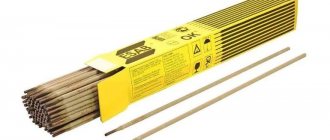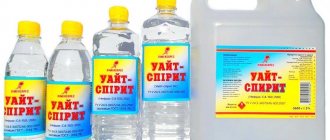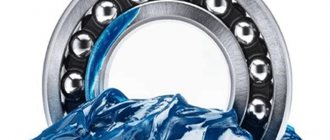“Tsiatim-201” lubricant is an antifriction multi-purpose lubricant used in lightly and moderately loaded sliding, friction and rolling units. The area of use of lubricant is aviation and automotive equipment, electromechanical drives, precision instruments, and so on. A special feature of “Ciatim-201” is that it is capable of operating at low temperatures (down to –60°C), low humidity and low mechanical loads. Due to this, it is widely used in cars in northern latitudes, in particular in the Far North.
Ciatim 201
Ciatim 201 lubricant is an anti-friction lubricant for versatile purposes. This type of lubricant was developed in the USSR. Designed for lubricating the structures of sliding, friction and rolling components and parts with light and medium loads.
A wide range of applications allows the active use of cyatim 201 in automotive and aviation equipment, electrical and mechanical drives and many others. One of its excellent properties is frost resistance; it does not harden even down to -60 degrees. Thanks to these characteristics, it solves the problems of rubbing components and parts in the Far North.
Developed in accordance with State Standard GOST 6267-74.
The word in the name of the lubricant “Ciatim” is an abbreviation, an abbreviation of the structural unit where this lubricant was invented, that is, it stands for Central Research Institute of Aviation Fuels and Oils.
Characteristics and Application
Thanks to the presence of various components in the composition, manufacturers have ensured that cyatim 201 has an operating temperature range from -60 to +90 degrees. The tensile strength is 500 Pa (Pascal).
Technical performance characteristics of "Ciatim-201" are indicated in the table:
| Characteristic | Meaning |
| Temperature operating range | –60°С…+90°С |
| Dropping point | +175°С |
| Effective viscosity at –50°С and average strain rate gradient 10/s, no more | 1100 Pa•s |
| Oxidation stability, mg KOH per 1 g, no more | 3 mg |
| Tensile strength at +50°С | 250…500 Pa |
| Mass fraction of free alkali in terms of NaOH | 0,1 |
| Evaporation at +120°C, in 1 hour, no more | 25% |
| Penetration at +25°С | Not standardized |
| Expiration date from date of issue | 5 years (60 months) |
| Colloidal stability, % extracted oil, no more | 26% |
| Corrosive effects on metals | Protects |
| Storage and transportation temperature | –30°С…+30°С |
| Content of free alkali in terms of NaOH, no more | 0,1% |
| Water content | Absent |
Features of the properties of cyathim 201
| Specifics of properties | |
| 1 | Due to its soft consistency and lack of stickiness, the lubricant can be mechanically washed off from exposed surfaces. |
| 2 | The preservation properties of CIATIM-201 are low. |
| 3 | Under mechanical stress, the lubricant is quite destroyed; as a result, its tensile strength and toughness decrease. |
| 4 | Chemical stability is satisfactory, due to the presence of an anti-oxidant. |
| 5 | It does not compact when exposed to elevated temperatures or during storage. |
| 6 | The colloidal stability of CIATIM-201 lubricant is low. |
This lubricant does not belong to the toxic class according to its toxicity class, which means that no special personal protective equipment (PPE) is required.
If cyatim grease catches fire, you can extinguish it with kashma, for example, or foam, but not with water.
TEST METHODS
4.1. Lubricant samples are taken according to GOST 2517-85. The mass of the combined sample is 2 kg of lubricant. In case of disagreement in assessing the quality of the lubricant, the sample must be stored for at least five years.
4.2. Analysis of the lubricant for compliance with the requirements of this standard, in addition to the content of mechanical impurities, is carried out before its packaging. Mechanical impurities are determined in the lubricant packaged in containers.
4.1-4.2. (Changed edition, Amendment No. 1).
4.3. To determine the appearance, the lubricant is applied with a spatula onto a glass plate measuring 50x70x2 mm in accordance with GOST 111-90 using a template (internal dimensions 35x35 mm, thickness 2 mm) and viewed with the naked eye in transmitted light.
4.4. Corrosion testing is carried out on copper plates of grades M0k or M1k according to GOST 859-2001. Discoloration and slight reddish-brown coloring of the plates is allowed.
4.5. When determining colloidal stability, the ashless filter is moistened with liquid 132-24 according to GOST 10957-74. The grease is pressed out at a load of (200±10) g.
4.6. When determining the mass fraction of alkali, analytical grade toluene is used as a lubricant solvent. according to GOST 5789-78 and titrate the hot lubricant solution. (Changed edition, Amendment No. 2).
4.7. When determining mechanical impurities, a sample of lubricant is thoroughly mixed with 75 cm of gasoline until a homogeneous mass is obtained. The mixture is transferred to a separating funnel, 75 cm of 50% acetic acid is added according to GOST 61-75 and stirred vigorously until the lubricant is completely decomposed. After settling and separating the layers, the lower acetic acid layer is filtered. At the end of filtration, the filter is washed three to four times with hot distilled water and dried in a thermostat, then a layer of gasoline lubricant solution is filtered through the same filter.
Advantages and disadvantages of cyatim-201
Pros:
- This lubricant is not expensive, it is cheaper than its competitors.
- The substance is non-toxic, which makes its use safe.
- The lubricant is completely inert, neutral, that is, it does not corrode rubber and plastic parts.
- Convenient to use: does not flow, has good viscosity.
- It has good temperature properties, does not harden even in severe frost and does not spread in extreme heat.
Minuses:
- An open can of grease dries in the open air.
- Not for use of open parts of components and mechanisms. For example, I lubricated the hinges on the gates, at first the effect was good - the gates did not creak when opening and closing, but after a couple of weeks the lubricant hardened due to exposure to air. If you lubricate open parts of mechanisms, the lubricant even turns into hard pieces from exposure to oxygen, and such abrasive particles, on the contrary, accelerate the wear of rubbing parts.
- If stored for a long time, oil begins to separate from the composition of cyathim. Exfoliated lubricant will no longer have the declared capabilities. But there is good advice for this - do not buy a large jar of cyathim 201, a liter is enough.
- In steam where high loads on parts develop, such a lubricant should not be used.
Ciatim 201 is produced by different companies. Some are made in accordance with GOST 6267-74, and some are made according to their internal technical conditions (TU). You should pay attention to this when purchasing any product. If GOST is specified, then this is better than TU.
Application of CIATIM-201
Due to two main factors, low cost and frost resistance, this brand and model of lubricant is widely used in various industries. It is used in automotive structural components:
- for lubrication of starter and generator bearings, as well as for lubrication of electric motor bearings;
- for lubrication of the correcting axis of the ignition distributor;
- for lubrication of various rotating axes;
- for lubrication of plain bearings;
- for lubrication of rollers;
- for lubricating hinges;
- for lubricating cables;
- for lubricating the flexible speedometer shaft;
- for lubricating the steering rack;
- for lubrication of ball joints;
- for lubricating battery terminals to prevent oxidation.
It is forbidden to use Cyatim 201 in parts where water gets in and where there is high humidity, over 80%. It is useful to know the characteristics and when to use Litol 24 grease and graphite grease.
Lithium lubricants absorb water quite well. Therefore, if there is contact with water, cyatim absorbs it and deteriorates its performance characteristics. The same nuances should be taken into account when using Litol 24.
Where there is high humidity, you need to use calcium rather than lithium grease. Cyatim is not effective as a preservative.
Properties
Another important characteristic of the use of CIATIM lubricant is its chemical inertness towards substances such as hydrocarbons, elastomers, and polymers. The principle of dissolving like in such compounds does not work, since organosilicon liquid is not a hydrocarbon compound. It is worth noting that it is this fundamental property that allows the lubricant to be used in friction pairs such as metal-rubber, metal-plastic, plastic-plastic, etc.
But it is important to note that with such qualities it is impossible to use this lubricant in a metal-to-metal friction pair. The tribological parameters of such raw materials are too weak. They are not intended for use in conventional steel bearings. This is due to the fact that, due to its physical and chemical properties, the lubricant cannot be used in a metal-to-metal friction pair, since it is not capable of providing the necessary protection against wear. It is worth noting that it will also not be possible to create a suitable tribosystem from this lubricant with the addition of any triboadditive. This is explained by the fact that organosilicon liquid is not able to form a film that will separate parts and protect from friction.
Analogs of Ciatim 201
The Russian popular lubricant Tsiatim 201 has competitors in the market. We list the brands of cyathim analogues from foreign manufacturers:
- BP Energrease SY-HT 2 / BP Energris. This lubricant is used in components where parts are exposed to high temperatures. It protects against wear and is anti-wear. Has good performance indicators at different temperatures. It is an antioxidant substance, that is, it protects the surfaces of parts from the formation of oxides and further corrosion.
- Shell AeroShell Grease 6 / Shell AeroShell Grease 6. This type is mineral based. Is universal. The composition contains corrosion inhibitors that protect against oxides and destruction of the metal structure. Can be used both for lubrication of anti-friction bearings and other types of bearings and gearboxes. The temperature range at which the lubricant retains its properties is from -40 to +121 degrees.
- Shell AeroShell Grease 22 / Shell AeroShell Grease 22. This lubricant is of high quality. Its purpose is for highly loaded parts of units. Shell 22 contains a base oil of a hydrocarbon compound and a Microgel thickener. It protects against oxides, metal corrosion, and wear. The composition also contains additives that increase the load-bearing capacity. Temperature range from -65 to +204 degrees.
- Mobil Mobiltemp SHC 32 / Mobil Mobiltemp. Mobile 32 grease has a long service life. It is actively used for filling ball and roller bearings of various types (serviced and sealed). It also lubricates keys, screws, and closed-type gears. Temperature range from -50 to +180 degrees.
- Teboil 0-Grease / Teboil Griz. This lubricant is like cyatim, lithium. It is based on very liquid mineral oil. Used to lubricate rolling bearings under medium and low loads. It is also used to lubricate measuring and other various instruments that are used in the cold. Operating temperature range from -50 to +80 degrees.
- HUSKEY HTL-500 Ultra Low Grease / Husky. This lubricant is universal for components and structural parts of automobile vehicles. Temperature characteristics: from -75 to +221 degrees.
Analogs of Ciatim 201 made in Russia:
- Era.
- Zimol.
- Lita.
- MS-70.
- Cyatim-202.
- Cyatim-221.
- and others.
Differences between Ciatim 201 and Ciatim 221
You can use 221 cyatim instead of 201. But there are some differences you should know:
- Cyatim 221 is not a lithium, but a calcium multi-purpose lubricant. It is resistant to various temperatures and is also waterproof. 221 grease is based on silicone. It is used for various contacting metal-to-metal and metal-to-rubber pairs. Cyatim 201, if it comes into contact with rubber parts for a long time, can damage its integrity.
- Cyatim 221 has a wider temperature range, -60 to +150 degrees. And cyatim has 210, from -60 to +90 degrees.
- There is also a big difference in price. 221 costs 3-5 times more than 201.
- According to the stated characteristics, 221 cyatims can maintain their performance properties for up to 40 years. And cyatim 201 maintains its performance for 5 years.
- The production of 221 cyatim is carried out according to another State standard, GOST 9433-80.
EFELE frost-resistant lubricants are the ideal choice for low temperatures!
The EFELE brand product line includes several synthetic frost-resistant lubricants: EFELE SG-311 and EFELE SG-321. Greases work effectively under high loads and low temperatures, and are compatible with elastomers and plastics.
EFELE lubricants compare favorably with similar materials:
- Frost resistance up to -55. -60 °C.
- High anti-corrosion properties.
- Long service life.
- Compatible with most plastics and elastomers.
- Operation at high speeds.
- Resistant to washing off.
- High mechanical stability.
- Low shear resistance at subzero temperatures.
EFELE SG-311 is a plastic frost-resistant lubricant made on the basis of polyalphaolefin and lithium soap.
Compatible with plastics and elastomers. It is used for lubrication of high-speed rolling bearings of fans, friction units in cars: starter gears, drives and control gearboxes, locks, window drives, control cables, generator bearings, spindle bearings, guides of wood and metalworking machines and other friction units operating in conditions of low temperatures down to -60 °C and/or high speeds. The new frost-resistant grease EFELE SG-321 is designed taking into account all modern needs and is suitable for difficult and extreme working conditions. Calcium sulfonate-based lubricant can withstand shock loads, improves equipment reliability, provides water resistance and has high load-bearing capacity.
Universal frost-resistant synthetic-based lubricant EFELE SG-321 is capable of operating at low temperatures down to -55 ° C without thickening. Compared to other greases, it can withstand significantly greater loads. Used for bearings or other units with metal-to-metal friction pairs.
Conclusion
From the above data we can conclude that Ciatim 201 is very popular due to its low cost and excellent frost resistance. Among the disadvantages, it was noted that 201 does not have a wide temperature range and is not intended for lubrication of couples subjected to high, heavy loads. Cyatim 201 is also gyroscopic, that is, it is forbidden to allow it to come into contact with water. It also dries quickly in the open air.
For expensive cars and other types of equipment, you can now purchase analogues that have better characteristics, but are more expensive.
0
Author of the publication
offline 4 days
Lubricant composition
Made from inexpensive petroleum oils (no synthetics) with a low viscosity coefficient. Traditional lithium soap (scientific name - lithium stearate) is used as a thickener.
To improve the basic characteristics, an antioxidant additive is added to the composition. The base base is obtained using conventional sublimation, which leads to low cost - the main advantage of this lubricant.











